#2 September/1944
Explore tagged Tumblr posts
Text
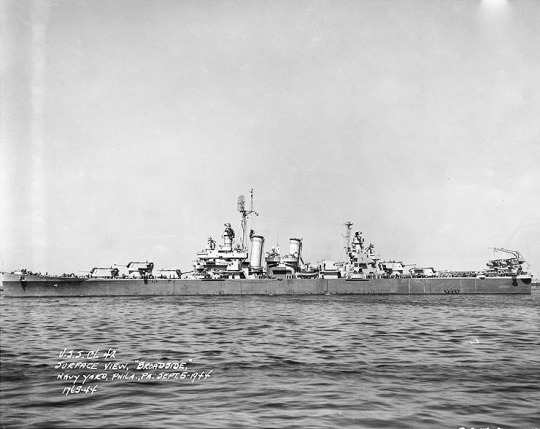
"USS SAVANNAH (CL-42) off the Philadelphia Navy Yard, following battle damage repairs and modernization."
Photographed on September 5, 1944.
U.S. Naval History and Heritage Command: NH 97955
#USS Savannah (CL-42)#USS Savannah#Brooklyn Class#Light Cruiser#Cruiser#Warship#Ship#Philadelphia Navy Yard#Philadelphia#Pennsylvania#East Coast#World War II#World War 2#WWII#WW2#WWII History#History#United States Navy#U.S. Navy#US Navy#USN#Navy#September#1944#my post
16 notes
·
View notes
Text

"The XP-67 after the fire on September 6, 1944. Once on the ground, the fire from the right engine spread to the rear fuselage and left nacelle. The rear fuselage was nearly burned through and collapsed to the ground. An inglorious end to both the XP-67 and XI-1430 programs."
source
#McDonnell XP-67 Moonbat#McDonnell XP-67#XP-67#fighter#prototype#September#1944#World War II#World War 2#WWII#WW2#WWII History#History#my post
44 notes
·
View notes
Text
#operation market garden was considered as a failure in September of 1944#it last 10 days with 41k troops and 17k killed#for a stretch of only 60mi of Holland.#then 3 months later in december 1944#the Ardennes offensive happened and then the battle of the bulge went on for nearly 2 months#by todays media standard the allied had failed and should be ready for americans to end future military support#especially when bastone was besieged the generals should’ve been sacked and Eisenhower resigned but we know what happened after#taiwantalk
2 notes
·
View notes
Text
August 2nd marks the International Day of Remembrance of the Roma Genocide Victims.
On the night of August 2-3, 1944, around 3,000 Roma prisoners were killed in gas chambers in the Auschwitz-Birkenau death camp. It took 52 years for this day of remembrance to be established, which was spearheaded by leaders of Roma organizations from 10 European countries and the USA.
Ukraine has observed this day since 2004. In this remembrance, there are 140 places of mass execution of Roma by the Nazis in Ukraine.
Babyn Yar was one of them. In September 2016, a memorial monument was put in place of a Roma tent covered in bullet holes from machine gun fire.

"Babyn Yar is a horror for Gypsies. They died without even knowing what they were being killed for,” says Roma writer Rani Romani (Raisa Nabaranchuk),whose grandmother died there.
On this day, the Holodomor Museum reminds us that, "it is crucial to emphasize again that human life is of the highest value, and human rights require unquestionable observance. Disrespecting and neglecting them leads to the gravest crimes."
#Ukraine#Holodomor Museum#Roma#history#International Day of Remembrance of the Roma Genocide Victims#Babyn Yar#thank you holodomor museum for bringing this to my attention#and now I try to spread this too
428 notes
·
View notes
Text
If you’re wanting to watch Band of Brothers/The Pacific/Masters of the Air in chronological order with BoB 1st Currahee episode split up in the dates on screen I made a list
(Updated: April 12, 2024 7:58pm pst)
July, 10 1942 Easy Company Trains in Camp Tocca (Band of Brothers Ep. 1 Currahee 2001) August 7, 1942, Allied forces land on Guadalcanal (The Pacific Ep. 1 Guadalcanal/Leckie 2010) September 18, 1942, 7th Marines Land on Guadalcanal (The Pacific Ep. 2 Basilone 2010) December 1942 The 1st Marine Division on Guadalcanal is relieved (The Pacific Ep. 3 Melbourne 2010) *June 23, 1943, Easy Company Trains in Camp Mackall N.C. (Band of Brothers Ep. 1 Currahee) * June 25, 1943, 100th Bomb Group flew its first 8th Air Force combat mission (Master of the Air Ep. 1 2024)
July 16, 1943 the 100th Bomb Group bombed U-Boats in Tronbhdim (Masters of the Air Ep.2 2024) August 17, 1943 the 4th Bomb Wing of the 100th Bomb Group bombed Regenberg (Masters of the Air Ep. 3 2024) *September 6, 1943, Easy Company Boards transport ship in Brooklyn Naval Yard (Band of Brothers Ep. 1 Currahee)* September 16, 1943, William Quinn and Charles Bailey leave Belgium (Masters of the Air Ep.4 2024) September 18, 1943 -*East Company trains in Aldbourne, England (Band of Brothers Ep. 1 Currahee)* -John 'Bucky' Egan returns from leave to join the mission to bomb Munster (Master of the Air Ep.5 2024) October 14, 1943, John ‘Bucky’ Egan interrogated at Dulag Lut, Frankfurt Germany (Masters of the Air Ep. 6 2024) December 26, 1943, 1st Marine Division lands on Cape Gloucester (The Pacific Ep. 4 Gloucester/Pavuvu/Banika 2010) March 7, 1944, Stalag Luft III Sagan, Germany, Germans find the concealed radio Bucky was using to learn news of the War (Master of the Air Ep.7 2024) *June 4, 1944, D-Day Invasion postponed (Band of Brothers Ep. 1 Currahee)* *June 5, 1944 Easy Company Boards air transport planes bound for Normandy (Band of Brothers Ep. 1 Currahee)* June 6, 1944, 00:48 & 01:40 First airborne troops begin to land on Normandy (Band of Brothers Ep. 2 Day of Days 2001)
June, 7 1944 Easy Company Takes Carentan (Band of Brothers 3x10 Carentan)
August 12, 1944, The 332nd Fighter Group attack Radar stations in Southern France (Masters of the Air Ep.8 2024)
September 15, 1944 U.S. Marines landed on Peleliu at 08:32, on September 15, 1944 (the Pacific Part Five: Peleliu Landing)
September 16, 1944 Marines take Peleliu airfield (the Pacific Part Six: Airfield)
September, 17 1944 Operation Market Garden -(Band of Brothers 4x10 Replacements)
October 22/23, 1944, 2100 – 0200 Operation Pegasus (Band of Brothers 5x10 Crossroads)
October, 1944 Battle of Peleliu continues (the Pacific Part Seven: Peleliu Hills)
December 16, 1944 Battle of the Bulge (Band of Brothers 6x10 Bastogne)
January, 1945 Battle of Foy (Band of Brothers 7x10 The Breaking Point)
February 14, 1945 David Webb rejoins the 506th in Haguenau (Band of Brothers 8x10 The Last Patrol)
April 5, 1945 506th Finds abandoned Concentration Camp
(Band of Brothers 9x10 Why We Fight 2001)
April 1-June 22, 1945 Battle of Okinawa (The Pacific Part Nine: Okinawa)
May 7, 1945, Germany Surrenders V-E Day - (Master of the Air Ep. 9 2024) - (Band of Brothers 10x10 Points 2001)
August 15 The Empire of Japan surrenders end of the War (The Pacific Part Ten: Home)
247 notes
·
View notes
Text

• Jake McNiece
James Elbert "Jake" McNiece was a US Army paratrooper in World War II. Private McNiece was a member of the Filthy Thirteen, an elite demolition unit. McNiece practiced in several operations throughout world war 2 with the 101st Airborne Division.
James McNiece was born on May 24th, 1919, in Maysville, Oklahoma, the ninth of ten children born to Eli Hugh and Rebecca McNiece, and of Irish American and Choctaw descent. During the Depression, the family moved to Ponca City, Oklahoma in 1931. In 1939, he graduated from Ponca City High School and went to work in road construction, and then at the Pine Bluff Arsenal, where he gained experience in the use of explosives. McNiece enlisted for military service on September 1st, 1942. He was assigned to the demolition saboteur section of what was then the 506th Parachute Infantry Regiment. This section became the Filthy Thirteen, first led by Lieutenant Charles Mellen, who was killed in action on June 6th, 1944, during the Invasion of Normandy. Following Mellen's death, Private McNiece became acting leader of the unit. McNiece is iconically recognized by wearing Native American–style "mohawk" and applying war paint to himself and other members of his unit which, excited the public's interest in this unit. The inspiration for this came from McNiece, who was part Choctaw.
McNiece's deliberate disobedience and disrespect during training prevented him from being promoted past Private when most Paratroopers were promoted to Private First Class after 30 days. McNiece would act as section sergeant and first sergeant through various missions. His first sergeant and company commanders knew he was the man the regiment could count on during combat. McNiece went on to make a total of four wartime combat jumps, the first as part of the Invasion of Normandy in 1944. In the same year he jumped as part of Operation Market Garden in the Netherlands. McNiece would see action again at the Siege of Bastogne, part of the larger Battle of the Bulge. During fighting in the Netherlands, he acted as demolition platoon sergeant. He volunteered for pathfinder training, anticipating he would sit out the rest of the war training in England, but his pathfinder stick was called upon to jump into Bastogne to guide in resupply drops. McNiece received a Bronze Star, Purple Heart, and French Legion of Honor medals for his service and deeds during the war.
His last jump was in 1945, near Prüm in Germany. In recognition of his natural leadership abilities, he ended the war as the acting first sergeant for Headquarters Company, 506th Parachute Infantry Regiment. McNiece would be kicked out of the military in February 1946 after fighting with MP’s. In 1949, McNiece returned to live in Ponca City. He began a 28-year career with the United States Postal Service. His first wife Rosita died in 1952 and, a year later, he married Martha Beam Wonders. They had two sons and a daughter and remained married until his death at age 93.
#second world war#world war 2#world war ii#wwii#military history#american military#army airborne#native american#biography#normandy#market garden
91 notes
·
View notes
Text
Fellow Travelers Timeline
(as comprehensive as i can make it. corrections/additions welcome)
1919-20 (?) - Hawk is born
based on tennis trophy which shows year 1936, and hawk's statement that he and kenny were on the tennis team in 11th grade (16/17 years old).

also date on the paperweight (1937) that hawk says kenny picked out on their senior trip. spring or fall though? if spring (usual for a senior trip, just before graduation), it would mean hawk graduated HS in 1937, b. 1919. (thanks, @lestatscunt!)

June 6, 1930 - Tim is born, on Staten Island, NY
birthdate/place shown on army application in ep 5
Gemini, with moon in Libra
>>> With a Gemini Sun Libra Moon, emotional equilibrium is hard for you to maintain in a world of constant flux and tension. Since you are not responsible for the woes and upsets of those around you, you should not feel so duty-bound to assuage their wounds or mediate every conflict that happens to come your way.
>>> your natural diplomacy, extraordinary perception and insight can all be applied creatively in such fields as politics, social work, and the mass media.
>>> your extreme open-mindedness would probably enable you to almost any life-style. You have a universal quality about you that transcends culture, religion, ideology, or any other barrier that divides mankind.
Fall 1937 - Spring 1941 - Hawk attends "Penn", presumably the University of Pennsylvania. (assuming hawk b. 1919)
(this is very very long, the rest is under the cut)
December 7, 1941 - bombing of Pearl Harbor, US enters WWII
??? - Hawk joins the army (along with Kenny), and is sent to Europe. Kenny is sent to the Pacific.
June 1, 1944 - The fall of Velletri (where Hawk got injured), which Hawk talks to Tim about in ep 3. (thanks @doodlingawaits!)
from wiki: The 36th U.S. Infantry Division commanded by General Fred Walker spotted a flaw in the German defenses on Mount Artemisio between Velletri and Valmontone. Between 30 and 31 May 1944, the 142nd and 143rd regiments penetrated the German defenses at Monte Artemisio, and on June 1 Velletri fell.
January 9 – August 15, 1945 - Battle of Luzon, where Kenny dies.
September 2, 1945 - Japan surrenders, US exits WWII
February, 1949 - Hawk starts working at the State Department
Hawk says in 1x04 (Dec 1953) that he's been working at the State Dept for "four years and ten months".
"I came out of the war with four assets: degree from Penn, a hero's war record, no particular political ideology, and a passing acquaintance with three languages. Throw in a talent for prevaricating and a taste for travel and fine clothes, you have the makings of a competent, mid-level Foreign Service bureaucrat."
Fall 1948 - Spring 1952 - Tim attends Fordham University, graduating with a degree in political science and history.
1951 - Hawk starts work for the Bureau of Congressional Relations
Tim mentions Hawk's been working there for two years during their meeting on the bench.
1952 - Tim works "the New York campaign" (presumably for Eisenhower).
1952/3? - Tim interns for three months at the Star, in the mailroom.
November 4, 1952 - Election Night, Eisenhower (R) wins the presidency. Tim/Hawk first meet and are instantly smitten. (ep 1)
February 16, 1953 to March 10, 1954 - McCarthy Hearings, part 1.
The first consisted of a series of hearings conducted by McCarthy, as the subcommittee’s chairman, throughout 1953 and early 1954 in which McCarthy alleged Communist influence within the press and the federal government, including the State Department, the U.S. Army, and the Government Printing Office.
March 5, 1953 - Stalin dies.
Late March, 1953 - Hawk/Tim second meeting
After Hawk meets Tim at the park bench, he attends a hearing where Marcus says Cohn has brought David Schine on, and then later at their lunch Senator Smith says, "McCarthy is sending Cohn and his sidekick to Europe..." This article, dated April 19, says that Cohn and Schine have been in Europe for two weeks.
Hawk mentions that it's near the end of the month, police need to make their quotas.

April 27, 1953 - Executive Order 10450 signed. Hawk goes to Tim's apartment and tells him about Kenny. (ep 1)
June 6, 1953 - Tim's 23rd birthday (Hawk 'misses' it because they weren't talking for 4 weeks. belated celebration in ep 3.)
June 15, 1953 (?) - date of the newspaper Tim is reading just before he goes to visit Hawk in ep 2, where Hawk makes him write the letter to Mary. I'm choosing to believe this is a mistake on the show's part, because this would mean that Hawk has already missed Tim's birthday.

June 19, 1953 - Julius and Ethel Rosenberg's execution. Hawk comforts Lucy about this at the end of ep 2. So, likely Hawk and Tim had their big fight very shortly before Tim's birthday, and weren't talking from end of May - end of June.
End of June, 1953 - at the end of ep 2, Tim says it's been 4 months since his last confession, making his last (proper) confession the end of Feb or beginning of March. (ie, before he meets Hawk again on the park bench).
End of June or beginning of July, 1953 - weekend trip to Rehoboth Beach (ep 3)
November 1953 - G. David Schine drafted into the army (ep 3)
Christmas 1953 (ep 4)
March 16 to June 17, 1954 - Army-McCarthy Hearings (part 2) (ep 5)
The second phase involved the subcommittee's investigation of McCarthy’s attacks on the U.S. Army. Known as the “Army-McCarthy hearings,” they were broadcast on national television and they contributed to McCarthy’s declining national popularity. Five months later, on December 2, 1954, the Senate censured McCarthy.
June 6, 1954 - Tim's 24th birthday
June, 1954? - Tim/Hawk break up, Hawk proposes to Lucy (ep 5)
I believe this happens at the tail-end of the Army-McCarthy hearings, so before June 17th. Unclear when the proposal actually happened though.
Fall, 1954 - Sen. Smith's funeral
based solely on fall foliage in this screenshot:
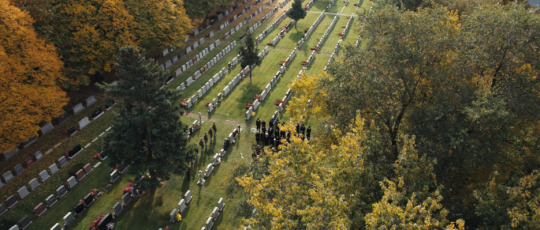
Late Nov / Early Dec, 1954 - Tim enlists in the army
based on army application: birthdate 6/6/30, age: 24 years, 6 months
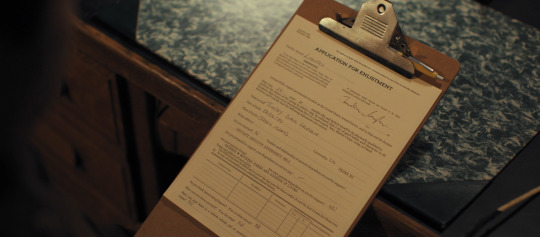
Late Nov / Early Dec, 1954 - Hawk/Tim last meeting in the tower
based on the radio program Tim is listening to, which says, "Chief Counsel Roy Cohn has resigned from the committee. And Senator McCarthy, his approval ratings plummeting, faces censure or even expulsion from the Senate." (McCarthy censured Dec 2).
Tim leaves for Fort Dix, for training, but is later stationed at Fort Polk, in Vernon Parish, LA. (thanks, @jesterlesbian!)

December 2, 1954 - the Senate censures McCarthy.
Summer or Fall 1956? - Tim's letter (that lucy burns) (ep 6)
Flashbacks, for context:
"Since he's giving up his apartment, Hawk insists on having a lair in the woods." // "I'm surprised that he finally agreed."
Lucy lets contractor go. // "Give me a baby."
Hawk is reading the Bristol Daily Courier, a paper located in Bristol, PA, a town in Bucks County, outside Philadelphia. I can't find any info on the one headline I can read though ("Heath Carlson breaks arws deadlock, locals proud"), so can't date this properly.
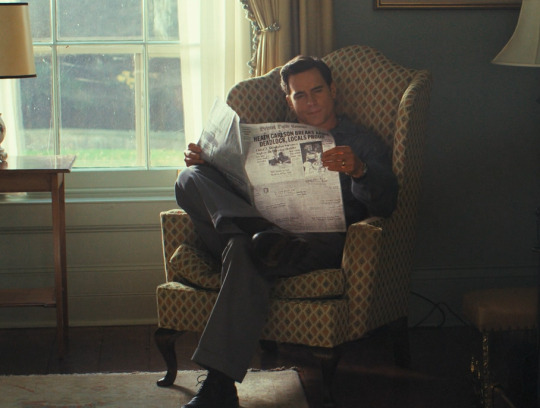
Lucy cleaning out Hawk's apartment, finds paperweight, sees Tim drop off letter. (did she start clearing out the apartment only after the cabin construction was complete? or before?)
"I went into the Army to get away from you. I thought time and distance would help. But it hasn't." If Tim sends the letter in summer 1956, it's been a year and a half since he enlisted.
Biggest question here: did lucy ask for a baby before or after she read Tim's letter??? the flashbacks don't answer this definitively.
October, 1956? - Lucy becomes pregnant with Jackson (see note under April 1957)
October 23 – November 4, 1956 - Hungarian Revolution of 1956
October 23, 1956 - April 30, 1957 - Hungarian Refugee Crisis
November 8, 1956 - Operation Safe Haven commences
President Eisenhower declared that 5,000 Hungarians would be awarded visa numbers remaining under the 1953 Refugee Relief Act
Spring 1957? - Tim sends telegram. It looks like 05-??-???? to me, which doesn't really make sense if McCarthy died on May 2nd, but it's hard to make out. or maybe telegrams used the date format dd-mm-yyyy.

April 1957? - Tim/Hawk first meeting, Lucy at least 5 (or 6? or 7?) months pregnant
You should feel your baby's first movements, called "quickening," between weeks 16 and 25 of your pregnancy. If this is your first pregnancy, you may not feel your baby move until closer to 25 weeks.
25 weeks ~= 6 months, and it still seems novel to her, so let's say she's approx. 6 months pregnant here.
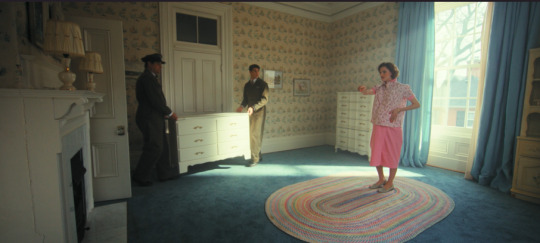

May 2, 1957 - Joe McCarthy dies.
May 6, 1957 - McCarthy's funeral. Tim's first visit to Hawk's apartment (ep 8)
June 6, 1957 - Tim turns 27.
June or July, 1957 - Jackson born (based on dates above)

1958? - Kimberly is born. (estimated bc she looks the same age or older than Jackson, so assuming she's a year younger at most.)
August, 1965 - President Johnson signs a law making it a federal crime to destroy or mutilate [draft] cards.
October 15, 1965 -David Miller publicly burns his draft card, becoming the first person to be prosecuted under that law and a symbol of the growing movement against the war.
May 17, 1968 - the Catonsville Nine took 378 draft files from the draft board office in Catonsville, Maryland and burned them in the parking lot. (inspo for Tim & co. thanks @brokendrums!)
November 1968 - ep 6. Hawk is 48-9, Tim is 38, Jackson is 11.
based on this newspaper screenshot when Hawk is talking to Marcus on the phone about Tim, which shows election results (1968 election took place on Nov 5th).
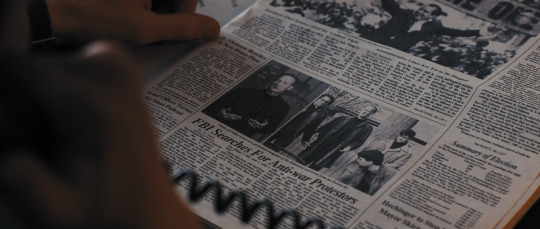
November 1968 - May 1970 (earliest) - Tim in prison. (he says in ep 7 he was in prison for a year and a half. this assumes he went to prison right away, but it could have been several months later if he was awaiting trial/sentencing.)
1970? - After prison, Tim moves to San Francisco and gets his counseling degree.
Mid-late 1970s - Tim earns his C-SWCM qualifications, requiring:
A Bachelor’s degree in social work from a graduate program accredited by the Council on Social Work Education
Documentation of at least three (3) years and 4,500 hours of paid, supervised, post-BSW professional experience in an organization or agency that provides case management services
Current state BSW-level license or an ASWB BSW-level exam passing score.
nb. because Tim already had his bachelors (from Fordham, majoring in history), I could see him entering a much-accelerated BSW program, transfering a lot of credits from his previous degree. That would give him maybe 2 more years of university, plus the required 3 years of post-BSW work = 5 years minimum before he earns that business card.
February 4, 1977 - Fleetwood Mac's album Rumours is released, including the 1970s Tim/Hawk anthem, Go Your Own Way
October, 1978 - Jackson dies

November 27, 1978 - Harvey Milk assassinated
May 20-22, 1979 - Tim on Fire Island (ep 7). Hawk is 59 or 60, Tim is 48, about to turn 49.
May 22, 1979 - Harvey Milk's (posthumous) 49th birthday (celebrated in ep 7)
1986 - ep 8
how long was Hawk in San Francisco? Timelines for the events below may be fudged in the show, bc I doubt he was there for 5 months.
March, 1986 - Roy Cohn's 60 Minutes interview, which the gang watches in ep 4.
April 15, 1986 - US bombs Libya. in the first episode you can hear reference to this on the radio, before Hawk leaves for San Francisco. (thanks @aliceinhorrorland93!)
July 27, 1986 - In California, Gov. George Deukmejian vetoes a bill that would have defined AIDS as a physical handicap calling for entitlement to protection under the state's civil rights laws.
August 2, 1986 - Roy Cohn dies (ep 8)
Late 1986? - the fundraising gala that Tim crashes, shortly after Cohn's death.
September 1986 - The State Legislature has passed another bill [in addition to the one vetoed on July 27]. Mr. Deukmejian, a Republican running for re-election, has indicated that he will probably veto the bill. (nb, this is likely the bill that Tim & co want to pressure the governor to sign).
October 11, 1987 - AIDS memorial quilt first displayed (ep 8)
--
this was a collaborative effort! many thanks to @ishipallthings for many of these details, as well as @startagainbuttercup , @alorchik, @itsalinh and others in the FT discord!
#i made this as comprehensive as i could but i would LOVE feedback/corrections#esp re: anything in 1956-1957 era#jackson's birth? and the date of that letter???#fellow travelers#timeline#reference#ft timeline#fellow travelers timeline#*
288 notes
·
View notes
Text
To my beloved ones who need this
This last 24 hours, I saw a concerning amount of 'if he wins - I'm ending my life' messages. I will understand, if you don't feel like I have a right to talk about this situation, as I am not an American citizen. But if it's cool with you - I have 8 things that helped me personally to stay, when things around went south.
Give yourself time to mourn. You have every right to feel like you feel right now. Even if you couldn't take part in what is happening. This is your life and it matters. Cry openly at home if it's a safe space. You can share your feeling with me, if your home is not safe. Eating your feelings up may sound like a good strategy in a short run, but it will have a backsplash later.
Don't give yourself too much time to doomscroll. I don't mean this like 'don't read the news at all'. I know, It's extremely hard to control this, but this is important. Give yourself time. Like 'ok, I'm doomscrolling from 1 to 2 pm. After that, I'm writing that fanfic, reading that book, shopping for groceries'.
Do mundane household things. Right now, it might feel like you don't have any control over your life. Like tomorrow, angry people come at your door and burn you. I understand, where does this come from, but I also understand that this feeling can grow into an all consuming fear, that might end you. So it is important to fight over this sense of control. 'I am in control of what I'm eating today, I am in control of what bedsheets I'm sleeping on today'. These are very tiny things, but they might help you from sliding down the fear.
Walk. If it's safe for you - please go out. I know, it doesn't cure depression, but I promise you, forcing your brain to analyze new information (new scents, dynamic surroundings) for maybe an hour a day helps in keeping yourself from circling around one damaging idea.
Acknowledge, you are not alone in what you feel right now. One of the scariest things your brain can decide right now is 'I am alone, I'm surrounded by enemies'. The truth is, you are not alone in this. There are millions of people mourning with you right now. Concentrate on them. If it helps - watch streams with their demonstrations, read their articles, do anything to not forget, they are out there.
It may now seem like you lost some of your relatives and friends. Don't forget that you don't have to force yourself to communicate with them right now. But also don't forget that you are not obliged to declare 'from now on I don't have a father/granny/sibling'. Maybe you will burn all the bridges, maybe with time you find some way to talk to each other despite what happened. Don't force yourself to choose right now because it's a very hard thing to do.
Make a small plan for 6 months from today. And I don't mean 'plan every week'. No, do a little thing. Buy a cinema ticket or a train ticket to somewhere not too far from your home, sign up for a 'prettiest origami contest', ANYTHING. But it must be not for tomorrow, it must be a long term plan. This little anchor might give you a little help.
Right now, it might feel like this is the end. But as someone who was there more than once: I promise you, this is not. This is not necessarily the end for you personally when a tyrant comes to rule your country, when he brings to life the most inhuman laws, when he starts a genocide. I don't mean this as 'stop whining, you softie, you are exaggerating this'. You are not exaggerating. As well as many people in Europe weren't exaggerating, when they acknowledged 1. September 1939 as the day, when the Evil took over the world. There are some diaries left from that time, that end abruptly in 1942 or even 1944 with the author taking his life, declaring, that this heel of a war will never end. But we all know that September 1945 and the war was over. Our task right now is to live to that day.
I love you all. I mourn with you.
34 notes
·
View notes
Text

A 3.7-inch AA gun of 97th Heavy Anti-Aircraft Regiment (London Scottish) bombarding enemy positions on the Gothic Line, 2 September 1944
28 notes
·
View notes
Text
Here’s something I’ve been translating on and off for the past week or so! I was looking at old German youth magazines in order to find interesting articles about classic rock bands (specifically Pink Floyd) and came across this in the 01/1978 issue of BRAVO magazine (One of the most famous teen/young adult magazines in Germany that’s been there since 1958 and is still going strong today!) A lot of youth magazines back in the day had articles and posters about rock bands because, well, that’s the people who were celebrities at that time! This page includes both short descriptions of the band members and a short history of the band up until that point when the issue came out! Enjoy ;)
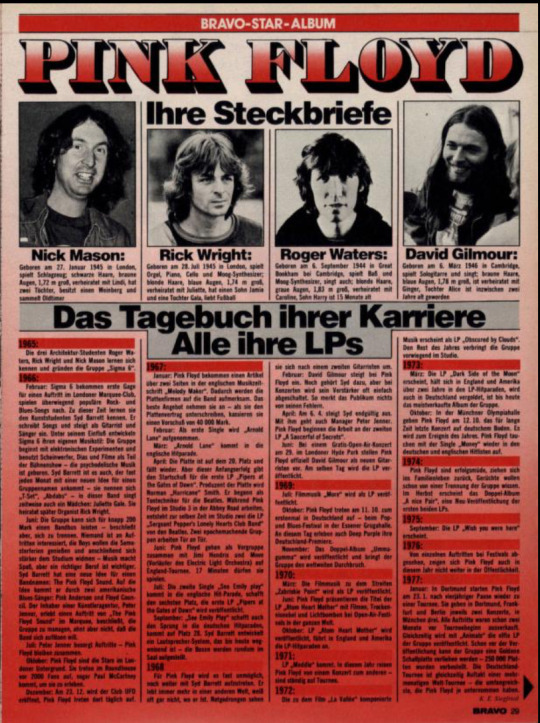
Here’s the original picture
And here is the translation! (Italized text are context comments added by me to add to the understanding of this text!)
Warning: Some of the information here is obviously incorrect!
Pink Floyd: Their profiles
Nick Mason:
Born on the 27th of January 1945 in London, plays drums, has black hair, brown eyes, is 1,72 m tall (for non metric peeps it’s approximately 5 foot 8), is married to Lindy, has two daughters, owns a vineyard and collects old cars (old timers in German means old/vintage cars)
Rick Wright:
Born on the 28th of July 1945 in London, plays the organ/keyboard, piano, cello, and Moog-synthesizer; has blonde hair, blue eyes, is 1, 74 m tall (approximately 5 foot 9), is married to Juliette, has a son named Jamie, and a daughter named Gaia, loves football (or soccer for American peeps)
Roger Waters:
Born on the 6th of September 1944 in Great Bookham near Cambridge, plays bass, Moog-synthesizer, and sings as well; has blonde hair, grey eyes, is 1,83 m tall (approximately 6 feet), is married to Caroline, and has a 15 month old son named Harry.
David Gilmour:
Born on the 6th of March 1946 in Cambridge, plays lead guitar and sings; has brown hair, blue eyes, is 1,78 m tall (approximately 5 foot 10), is married to Ginger, and has a 2 year old daughter named Alice.
The diary/summary of their career; All their albums
1965
The three architecture students Roger Waters, Rick Wright, and Nick Mason meet and get to know each other, establishing the band Sigma 6.
1966
February: Sigma 6 gets their first fee for a performance in the London Marquee Club and mostly cover popular rock and blues songs. During this time they meet art student Syd Barrett. He writes songs and joins the band as a guitarist and singer. Under his influence Sigma 6 evolve into their own music style: The group does electronic experiments and uses spotlights, reversal film, and recorded footage as part of their stage shows. Thus psychedelic music is born. Syd Barrett is as well (psychedelic), who now comes up with new names for the band almost every month — they call themselves “T-Set,“ “Abdabs” — and in this group a girl sings as well from time to time: Juliette Gale. She later marries keyboardist Rick Wright.
June: The group could pay for a band bus for approximately 200 Mark (the German currency at the time of this article), but decide to separate for the time instead. No one is interested in performing, since the boys want to enjoy the semester holidays as well as after them improve and work harder on their studies; music is fun but a real job is more important. Syd Barrett then has a new idea for a band name: The Pink Floyd Sound. He comes up with his idea through combining the names of two American blues singers: Pink Anderson and Floyd Council. The owner of an artist agency, Peter Jenner, sees a performance from The Pink Floyd Sound in the Marquee, and then from there on decides to manage the band, not knowing the band wanted to break up.
July: Peter Jenner gets the band gigs, and thus Pink Floyd stays together.
October: Pink Floyd are now the stars of the London Underground. They perform in the Roundhouse to 2000 fans, with even Paul McCartney being there to see them.
December: On the 23rd of December the UFO club opens, with Pink Floyd performing there daily henceforth.
1967
January: The English music magazine “Melody Maker” write an article about Pink Floyd, which makes record companies curious about the band. The band accepts the best offer, and as they sign the record label contract, they cash in an advance payment of 40 000 Mark.
February: The first single “Arnold Layne” gets recorded.
March: Arnold Layne goes to the English hit charts.
April: The single is on number 20 in the charts and then falls off. But this beginning success gives them the push they needed to record their first album “The Pipers at the Gates of Dawn.“ Norman “Hurricane” Smith serves as producer for this album, and began his career as a recording engineer for the Beatles. While Pink Floyd work on their album in studio 3 of Abbey Road studios, the Beatles work on their album “Sgt. Pepper’s Lonely Hearts Club Band” at the same time in studio 2; two decade defining groups working next door.
June: Pink Floyd join as a supporting act along with Jimi Hendrix and the Move (runner up band to Electric Light Orchestra) for an England tour, but only get to play 17 minutes.
July: The second single “See Emily Play,“ becomes part of the English hit charts, coming in at number 6, and the first album “The Pipers at the Gates of Dawn” releases.
September: See Emily Play also goes into the German hit charts and reaches number 28. Syd Barrett at this time also creates a speaker system which is still useful today, where the speaker boxes are placed all around the room.
1968
At this time, it is practically impossible for Pink Floyd to continue performing with Syd Barrett. He is more and more off in his own world and mind, often not knowing where he is. Out of necessity, the band thus searches for a second guitarist who could join the band.
February: David Gilmour joins Pink Floyd. Syd is still part of the band, but during concerts his amps are often not even turned on, so that the audience doesn’t know any better about his mistakes.
April: On the 6th of April Syd definitively leaves the band, with manager Peter Jenner going with him. Pink Floyd begin working on their second album “A Saucerful of Secrets.“
June: At a free open air concert on the 29th in the London Hyde Park the band officially announces and debuts David Gilmour as their new lead (and only) guitarist. On the same day the new album releases as well.
1969
July: The soundtrack album Pink Floyd worked on for the film “More,” releases.
October: Pink Floyd have their first concert in Germany on the 11th of October at the Pop and Blues Festival in the Essen Grugahalle venue. On this day, Deep Purple celebrate their first concert in Germany as well.
November: The double album “Ummagumma” releases and makes the group successful worldwide for the first time.
1970
March: The soundtrack album Pink Floyd worked on for the film “Zabriskie Point” releases.
June: Pink Floyd perform the title track of their upcoming new album “Atom Heart Mother” worldwide at open air festivals with recorded footage, dry ice fog, and light bombs as part of their special effects on stage.
October: The album “Atom Heart Mother” releases and leads the album charts in England and America.
1971
The album “Meddle” comes out. This year Pink Floyd is particularly busy; they go from one concert to the next and have multiple tours worldwide.
1972
The soundtrack album Pink Floyd worked on for the film “La Vallée” releases under the title “Obscured by Clouds” as their new album. The rest of the year the band spends inside the studio.
1973
March: The album “Dark Side of the Moon” releases and is on the English and American album charts for over two years, and also goes gold in Germany. It is to this day the band’s most sold album.
October: Pink Floyd perform their last German concert for a long time on the 12th of October at the Olympiahalle in Munich, and it becomes the sensation of the year. Pink Floyd also make their way into the English and German single charts again with the single “Money.”
1974
Pink Floyd are tired of success and go back to their private family lives, with rumors appearing that the group will break up. In autumn, the double album “A nice pair” comes out, which is a rerelease of their first two albums.
1975
September: The album “Wish You Were Here” releases.
1976
This year, Pink Floyd doesn’t appear publicly that much as well, except for some performances at festivals.
1977
January: In Dortmund Pink Floyd start their first German tour since 3 years ago on the 23rd. They have 2 concerts each for Dortmund, Frankfurt, and Berlin, with Munich having 3. All concerts were sold out 2 months before the tour started. Simultaneously the 11th album of the band, “Animals” releases. Even before the album released, “Animals” goes gold, with 250 000 records being preordered. This German tour is also the starting point of a months long worldwide tour — the most comprehensive one that Pink Floyd have undertaken yet.
Written originally by: K. E. Siegfried
Translated from German to English by: me! (Vik)
(Btw my source to where I found this is the Internet archive, love that place!)
also here are some pictures that were included in the magazine of the band!
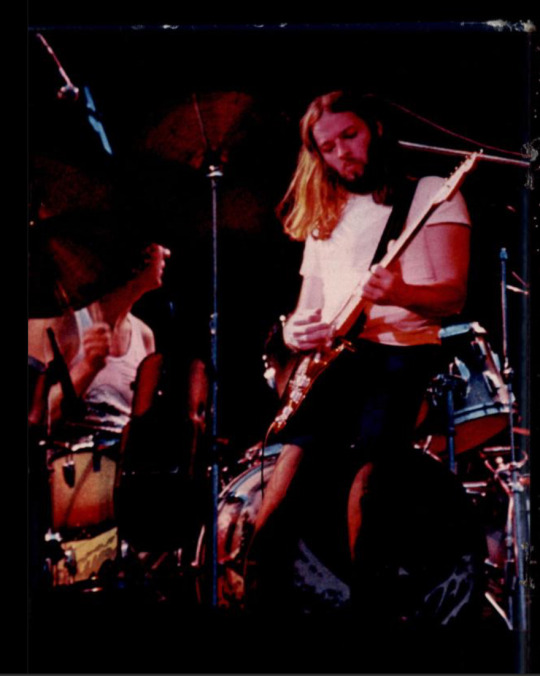
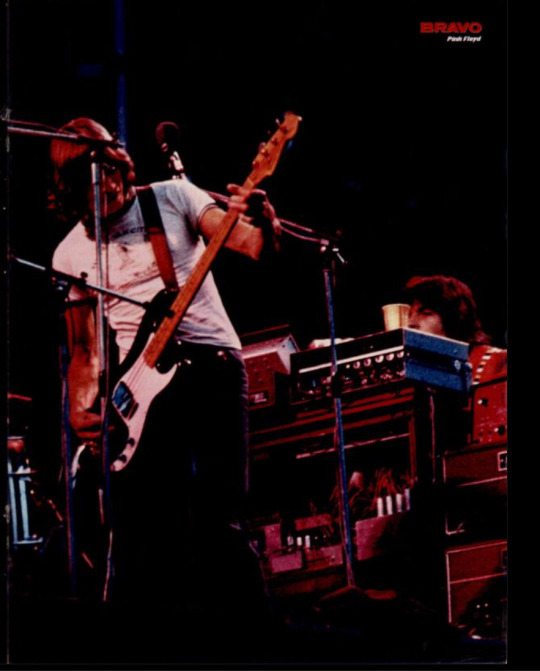
#Pink Floyd#rock photography#classic rock#60s#60s rock#70s#70s rock#roger waters#david gilmour#nick mason#rick wright#richard wright#syd barrett#rock history#music history#60s music#70s music#translation#magazine article#old magazines
42 notes
·
View notes
Text


USS NORTH CAROLINA (BB-55) off the Puget Sound Navy Yard, Bremerton, Washington.
Photographed on September 24, 1944.
US Navy Photo: 3110-44
Battleship North Carolina Archives: 2014.008.015
#USS North Carolina (BB-55)#USS North Carolina#North Carolina Class#battleship#Warship#ship#boat#September#1944#World War II#World War 2#WWII#WW2#history#military history#military#puget sound navy yard#puget sound#Washington#west coast#united states navy#us navy#navy#usn#u.s. navy#my post
84 notes
·
View notes
Text
"The globe"
---
By the dawn of a century christened as both the American and the geographic century, [...] European explorers and cartographers actively filled the last [apparently] remaining terrae incognitae [on their maps and globes] [...] and excited economic [...] interest [...] in near and far parts of the world and their markets. As imagined [...] in ambitious [...] projects such as the "Millionth Map" [...] in 1891, this world was deemed a sufficiently homogeneous entity […]. [A]t least among the white, free populations of various metropoles[,] […] Europeans [...] established one single imaginary of the world, [...] a meticulously surveyed global environment. [...] On the Western side of the Atlantic, on the other hand, maps and globes heralded, braced, and promoted the expansionist projects of [...] a century of national coming of age for the United States [...] [and its] spatially unsettled, globalizing empire. [...] Americans viewed maps and globes [...] as "arbiters of power" [...]. Drawing a direct line between geography and wars of empire, President McKinley, for instance, told an audience of missionaries […] that, once his prayers to God about the “Filipino question” had been answered, his first presidential order was for “the chief engineer of the War Department (our map-maker) to put the Philippines on the map of the United States” [...]. Americans [...] needed to pay special attention [...] to those recently-made-cognita regions (such as the Philippines, Hawaii, Guam, and Puerto Rico [occupied by the US]) [...]. [H]oping to materialize the "global Monroe Doctrine," [...] Americans' lives were mapped onto a cartographically known, commercially accessible, cognitively smaller world [...], inscribing it in their own “imperial vernacular” [...].
Text by: Mashid Mayar. "What on Earth! Slated Globes, School Geography and Imperial Pedagogy". European Journal of American Studies 15-2. Summer 2020.
---
Simply put, World War II made the United States a planetary presence. State Department officials furiously churned out wartime memos establishing U.S. policy - often for the first time - regarding every nation, colony, region, and sub-duchy on the map. [...] In 1898 imperial expansion had inspired new maps. The 1940s wartime expansion yielded a similar burst of cartographic innovation. [...] Life devoted a fifteen-page spread to the “Dymaxion map” [...]. More popular was the “polar azimuthal projection” perfected by the dean of wartime cartography, [R.E.H.]. [...] The map was an enormous hit, reprinted and copied frequently. [...] The U.S. Army ordered eighteen thousand copies, and the map became the basis for the United Nations logo, designed in 1945. “Never before have persons been so interested in the entire world,” gushed Popular Mechanics. [...] The world must be seen anew, the poet Archibald MacLeish wrote, as a “round earth in which all the directions eventually meet.” “If we win the war,” he continued, “the image of the age which now is opening will be the image of a global earth, a completed sphere.” That word MacLeish chose, global, was new. [...] If the last war was a world war, this one was, as Franklin Delano Roosevelt put it in September 1942, “a global war.” That was the first time a sitting president had publicly uttered the word global, though every president since has used it incessantly. For Christmas that year, George Marshall presented FDR with a five-hundred-pound globe for the Oval Office. Placed next to Roosevelt’s desk, it was comically large. It resembled the globe with which Charlie Chaplin had performed an amorous dance two years earlier in The Great Dictator, only bigger. [...] “Just as truly as Europe once invaded us, with wave after wave of immigrants, now we are invading Europe, with wave after wave […],” wrote the journalist John Hersey in 1944. Except it wasn’t only Europe. The “invasion” landed in force on every continent [...].
Text by: Daniel Immerwahr. How to Hide an Empire: A History of the Greater United States. 2019.
---
[A]n empire's use of narratives of technological progress to expand towards the "ends of the earth" [...] naturalize[d] dominance over the global commons [...]. As the Pentagon declared in 1961, the “environment in which the Army, Navy, Air Force, and Marine Corps will operate covers the entire globe and extends from the depths of the ocean to the far reaches of interplanetary space” […]. Extraterritorial spaces, such as the high seas, Antarctica, and outer space, are imaginatively, historically, and juridically interconnected. Their international legal regimes […] [were] developed in the midst of the Cold War […]. [M]odern ways of imagining the earth as a totality [...] claimed for militarism […] derive from colonial histories of spatial enclosure. Denis Cosgrove [...] points to the [...] [late eighteenth-century British Empire's] encirclement of the globe through Cook's navigation of the seas, which allowed for colonial claims to expand to a planetary scale. [...] This circumnavigation in turn led to [...] establishment of Greenwich mean time as a world standard [...]. [T]his encirclement is both a spatial claim to the planet and a temporal one, in that it plots time from a British center. [...] In the memorable words of [...] McLuhan [from 1974, relating to US surveying] [...]: "For the first time the natural world was completely enclosed in a man-made container [...]." The first photograph of the earth from outer space was taken by a V-2 rocket shot from the White Sands Missile Range in New Mexico in 1946 […]. [A]n Apollonian eye, [...] the [...] photographs [...] were part of a context in which […] popular US magazines used wartime cartography in ways that naturalized militarism and empire under the guise of a unifying view of the globe.
Text by: Elizabeth DeLoughrey. "Satellite Planetarity and the Ends of the Earth". Public Culture, Volume 26, Issue 2, pages 257-280. Spring 2014.
22 notes
·
View notes
Text
IWTV S2 Musings - Tentative Timeline (Pt1: 1940 - 1948)
I've been struggling with this for a while, cuz this ish just don't make sense, AMC. (I fully expect S3 to gotcha/retcon/fix stuff, esp. since who knows what Armand's tinkered around with in Louis' head.) I split this timeline in 2 parts: Pt1 has everything from 2x1 - 2x6ish; and then ofc Pt2 will cover as much as I can understand from the Trial's shenanigans.
(I'm just one person tryna figure out wtf is going on, so if y'all have any insights, please share!)
1940 - 1945
Claudia & Louis cross Eastern Europe (2x1)
pre-February 6, 1940: Mardi Gras, NOLA.
1x7 diary entry (x x): "Dear Diary, I've been planning the trip out in my head. When we get to Europe, we aren't going to look at any of the touristy sights. We are instead going straight to the Black Sea and then on to the Carpathian Mountains. Those are the places I've been reading about in the books I've brought with me. We had to learn so much…." (Carpathian countries inc. Austria, Czech Republic, Hungary, Poland, Romania, Serbia, Slovak Republic, and Ukraine.)
Roget (2x2): "We have not heard from Monsieur de Lioncourt since February 1940, when we processed several wires for him, for a party he was throwing."
September 8, 1941: 1x4 diary entry, Ploiesti, Romania: "The POWs are malnourished, nothing but bone and sinew. Their blood is bitter. It almost makes you feel sick to drink it. Catch 'em as they trudge from their work in the oil fields every night. They don't have much strength to fight..." (Ploiesti bombed for its oil from 1941-1944.)
1944: Madeleine's head is shaved during Paris' épuration légale along with the other Nazi collaborators. (An IRL photo from June 21, 1944.) France's Nazi occupied Vichy regime: July 10, 1940 - August 9, 1944. [see De Gaulle below]

Pre-1945: Cross from Ukraine into Nazi Romania (again). Claudia is speaking German to the Nazi at the checkpoint, who says "Black Ukranian? Waffen-SS, Checkpoint 30317."
DREAMSTAT: "Four years of grim wayfaring, and still no sight of the benevolent vampire."
April 30, 1945: "In Germany, Herr Hitler had popped a pill in his bunker, and Europe celebrated."
1944 / 1945: "But in Romania, the champagne fizzled and went flat. Soviets replaced Nazis.... War became occupation." (Soviet occupation of Romania lasted from 1944 - 1958.) Stopped by the racist Soviets in Emilia's town.
Post-April 30, 1945: 2x1 radio announcement: "The triumph over Hitler's evil can be felt throughout France, and in no more fantastic an example than the priceless works of art being bundled up in the countryside, lifted on to trucks and returned to their rightful place in Paris. And we of the BBC World Service, speaking for the rest of the western world, send a most grateful thank you to our allies in France with one of your very own. ['Y'a Pas D'Printemps' by Edith Piaf plays]."
1944 / 1945: "There is No Spring” by Edith Piaf is recorded July 4, 1944.
Late June, 1945: Louis & Claudia leave Romania (after Emilia & Daciana died); near the 1-year anniversary of There is No Spring; right before Venus de Milo was about to head to Paris along with the rest of the "priceless works of art being bundled up."
July 2, 1945: Venus de Milo officially returns to the Louvre. Louis & Claudia arrived in Paris with it. (August 1945: Louvre reopened.) "Claudia was entirely broken. She had left a part of herself in Romania. I knew I had to steer her far away from it. I chose the city that called to us on the radio. To the mother of New Orleans.... The war had turned off the lights, stripped its streets of their beauty, sent its avant-garde into exile. But now, the whole world was ready to return, to remake their lives. Pilgrims on their hopeful way."
1945
Claudia & Louis in Post-War Paris (2x2)
1944 - 1946: Charles De Gaulle chairs the Provisional Government of the French Republic June 3, 1944 - January 26, 1946. "De Gaulle's Paris had me etherized. If Claudia and I were looking over our shoulder at all, it was in astonishment our skin did not attract the same attention it did in America."
May 8, 1945: France's Sétif and Guelma Massacre of Algierian citizens (Franco-Algerian relations evaporated). DANIEL: "Right, because there wasn't any racism in mid-20th century France. I think your Algerian inferiors of the time might disagree." LOUIS: "But I wasn't an Algerian. I was an American, and if there was an assumption that I'd arrived to blow a trumpet or sing for my supper, it did not register as a slight in those days. I was just grateful knowing no one wanted to lynch me, or direct me to the far end of the café counter!"
1944 - 1949: Black markets & rationing chokehold over Paris.
LOUIS: "We hid ourselves away in an inconspicuous apartment in Le Neuvieme, passing ourselves off as moneyed Americans, over-spending for black market baguettes. It was the perfect cover."
ARMAND: "The estate of the family De LaCroix. Whilst their countrymen clutch ration cards, they've made quite a killing manipulating the black markets."
1945 - 1950: Paris' economy impoverished. "No salt, no butter. Can't have milk unless you got a newborn. And read here, 'Hospitals running low on Plaster-of-Paris for a record number of broken bones due to decalcification and undernourishment.' You want francs in pockets? These people are broke! I saw a woman tonight in a patchy five-year-old dress putting on a brand new lipstick.... Paris is on her way back. Give her a little time, is all."

LOUIS: "Five months of anxiety-producing choices, and not one 'bonjour,' or 'prépare-toi à mourir'?!"
ARMAND: "Five months removed from their velvet-heeled arrival, the Americans were finally coming to Pigalle."
SANTIAGO: "Five months of nights. Five insolent months of nights, waiting for you to humble us with your appearance. I ask you, Maitre, was it worth the wait?"
November 1945: Armand confronts Louis; invites Louis & Claudia to the Theatre des Vampires. (June to November is 5 months.) (ARMAND: "I had lost patience. I was convinced we were being toyed with and I could hold back the coven only so long. I knew the park well myself, knew what went on in the rambles there, so I was not surprised to find him without the girl. I would confront the elder, and make him aware of the ways rogue vampires were dealt with in Paris.")
LOUIS: Armand knows all about Lestat. CLAUDIA: How long's he known?! LOUIS: The whole time. Read our minds, first night at the theater.
November 14, 1945: 1x4 diary entry: "We've arrived in Paris, what a relief! My whole dead self feels revitalized head to toe. We might be outsiders to both human and Parisian life, but I do appreciate both now with such fervor! Granted, I've never hated my body [more]...." This also matches with Claudia meeting Madeleine and wanting clothes tailored to her size. And also with Louis remarking that it was only at the Theatre that "Claudia absolutely loved them. And it was the first time in Paris I had seen a smile or a laugh come out of her that wasn't for my benefit." By mid-November, Claudia's unhappy mood had vastly improved.
mid-December 1945: The coven hunt at Chateau de la Croix. "Claudia had attended a month of performances and the coven felt she had proven herself sincere." (Mid-December means this was likely a Christmas party the coven crashed! 😂🤣) Armand warns Louis to stop visiting Roget, and stop lying to the coven about Lestat/"Bruce."
1946
Claudia's coven initiation period; Loumand's courtship
Spring 1946:
Estelle sneezes during No Pain: "It's hay season!" This makes no effing sense for vampires to have allergies, but whatever, it was funny.
Louis keeps cruising gay parks. "There was a park I'd heard about. I would go to this park often. I was an armored thing that spring, someone steady on his feet, but… With a history of chasing the wrong kind of love." It is impossible for Louis to mean Spring of 1945, cuz that's when Hitler died, and that's before Venus de Milo arrived in Paris. This also makes no sense, if we accept that Armand met Louis in Nov. 1945, five months after their arrival.
Loumand starts courting. (LOUIS: "I walk a new part of the city every night. I try to get lost. Somehow I always end up back by the river [Seine]." ARMAND: "I started spending less time at the theater and more nights strolling the boulevards with Louis.")
Claudia is initiated in the coven; she doesn't sleep in the apartment anymore. (2x4, "What the f**k's gone on without me here?!")
Spring - Summer 1946: Baby LouLou starts performing [See Sept. '47 below.]
1946: Jean-Paul Sartre: "Evil is the product of the ability of humans to make abstract what is concrete," (2x3). A wildly popular quote, which no one ever cites. I can only assume it's an English translation of something Sartre originally said in French. All I could find that came remotely close is his Oct 1945 - Dec 1946 speech(es) L'existentialisme est un humanisme: "If values are uncertain, if they are still too abstract to determine the particular, concrete case under consideration, nothing remains but to trust in our instincts." IDFK, I'm not into all that confusing philosophical blahblah.
1946 - 1949: Loumand's sexcapades, Louis' photography. (RASHID: "The Paris Albums, 1946-1949." LOUIS: "Those were our young friends. Humans. Guys." ARMAND: "Some are very old now, most are dead. And some we simply drained for sport. Well… generally me! Louis has his ways.")
1947
Spring - Summer 1947: Louis starts art dealing.
LOUIS: I bought a Fougeron from you early in the year. I was a little short of asking, so I threw in that watch I was wearing. ALOIS: Ah, yes, yes, a good watch. Where did you hang the Fougeron? LOUIS: Over my bed all spring. Then I sold it to Germain Seligman in summer.
Fall 1947: Claudia's sick & tired of Baby LouLou
LOUIS: "By the 500th performance, Claudia was beyond bored."
ARMAND: "So explain to the company why the 500th performance of 'My Baby Loves Windows' felt more like a slog than a celebration?"
500 nights = 16 months, or 1.3 years, assuming Claudia did 1 performance every single night. In 2x4 Armand said: "Fifteen minutes a night to pretend."
CELESTE: Maitre might not have noticed as he has been nomadically attending the Theatre Des Vampires. SANTIAGO: And the infection spread what, year and a half ago? CELESTE: When a certain vampire was granted dispensation from coven membership.
September 1947: Boris Vian/Vernon Sullivan's Les morts ont tous la meme peau published. If we take Louis reading Vian's book the month it came out, in September, and 16 months of Baby LouLou performances, Claudia would've had to have started performing around June/Summer of 1946, give/take a few months, depending on when Louis got the book, and how regularly Claudia performed.
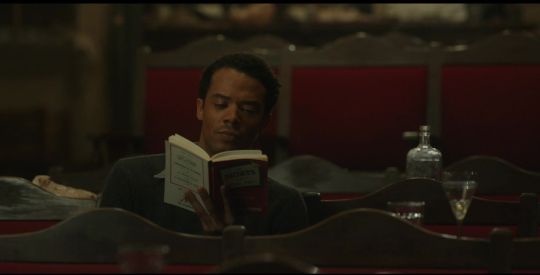
Fall 1947: Louis discusses R-26, where he's been visiting in 2x4.
ALOIS: So, you've been showing your work at the Perriers' salon? LOUIS: Always something interesting happening there. ALOIS: Maybe before the war more than now. But then I'm rarely out of my gallery.

Late 1947 - Early 1948
(There's A LOT that happens from 2x4 - 2x6 that I'm really unsure of. The ONLY diehard dates I have are for Louis' Wols painting, and Sam's Godot play. So I have to assume everything below happens within that timeframe.)
Celeste, Estelle & Santiago investigate Lestat at Roget's.
Armand lies about the Maitre coup: "In retrospect, the buffoon was in the audience, oblivious to the conspiracy uniting around him."
Madeleine almost gang-raped; Claudia reveals her vampirism
Claudia's final diary entry "Diaries are friends of last resort. I have found one not made of paper and glue. F**k these vampires."
Louis buys the Wols / Let's Go Sunning plays on the radio(?)
Louis meets Madeleine; Armand meets Madeleine
Sam's Godot play
Late 1947 - Early 1948: Santiago's Maitre coup starts; steals Claudia's diaries. Louis dumps DreamStat; Loumand's Arun/Maitre roleplay starts. (Because of the rain & lack of snow, I wonder if this is Fall 1987 / Spring 1948?)

Late 1947 - Early 1948: Sam starts writing several scripts:
Whatever play Santiago was rehearsing for, in 2x6's title "Like the light by which God made the world, before He made light." Meanwhile, the coven is passing around Claudia's diaries.
Waiting for Godot
The Trial script(?)
Late 1947 - Early 1948: Celeste, Estelle & Santiago investigate Lestat at Roget's.


Late 1947 - Early 1948: Louis buys a Wols (Alfred Otto Wolfgang Schulze), It's All Over The City (1947).





(Question: Is Jack Shaindlin's Let's Go Sunning (which plays as Santiago eavesdrops on Loumand banging) anachronistic, or does AMC know something I don't--more than likely--cuz Google keeps telling me it was first used in 1954 in the film Garden of Eden?)
Late 1947 - Early 1948: Louis meets Madeleine; Armand meets Madeleine (the same night, since they're all in the same clothes).


1948
HUGE timeskip. The ONLY definite timeframe I have is Godot.
October 9 1948 - January 29 1949: Waiting for Godot, by The Vampire Samuel Barclay / IRL Samuel Barclay Beckett.

Right after this scene, they cut to Dubai!Louis describing IRL events from 1949. So I'm cutting this post off here, to put all of that in context wrt the Trial, that also happened in 1949.
#interview with the vampire#louis de pointe du lac#loumand#the vampire armand#iwtv tvc metas#justice for claudia#read a dang history book#europe#i hate math#louis de pointe du black
28 notes
·
View notes
Text
Emily Returns to England!
After spending time away in the United States, Emily Bennett has made her way back to London this spring. She hopped a plane with me on my way to study abroad, and she’s so excited to be back! I made her a special trousseau to commemorate the occasion. Let’s see what’s packed!

Emily made the trip across the Atlantic in her big wool coat. The coat is from Kit’s collection, but Emily is borrowing it for now- springtime in London can still get pretty chilly, so the extra warmth is more than welcome.

She has her dress gifted to her by Aunt Prim- she loves its cheery flowers and adorable cherry print.

Emily’s red floral blouse has pintucks on the sleeves and two big tortoiseshell buttons, and her teal skirt matches the little flowers on her blouse.

When VE Day arrives, Emily can celebrate in her yellow floral dress with tiny brown buttons and gold trim. Emily’s clothing would probably be part of the Utility Clothing Scheme, introduced in 1941 in the effort to counteract inequalities in access to clothing. CC41 clothes used less material and were price controlled to help everyone afford new clothes during rationing.

Earlier in the war, during the Blitz proper, Emily might’ve worn a siren suit- a warm one-piece garment designed to be quickly pulled on over the pajamas and keep the wearer cozy and covered during the nightly air raids. Emily’s story is technically not set during the Blitz, as that occurred from September 1940 to May 1941, with smaller and more sporadic bombing raids afterward; rather, her time is during the so-called Baby Blitz, in which the Germans used V-1 flying bombs and later V-2 rockets to cause relatively less damage to London than in previous years from January to May 1944. After the final air raid in March 1945, Emily could kiss the siren suit goodbye.
Emily is so glad to be back at home, and hopes to spend many sunny days ahead enjoying England!
56 notes
·
View notes
Text

Princess Anne to represent King at events to mark 80th anniversary of Arnhem
12th September 2024 at 4:42pm /// Forces News
Princess Anne will travel to Oosterbeek in the Netherlands to commemorate the 80th anniversary of Operation Market Garden – one of the Second World War's most famous battles.
The Princess Royal will be representing the King at events during the two-day visit accompanied by her husband Vice Admiral Sir Tim Laurence.
In 1944, the Allies came up with an ambitious plan – codenamed Market Garden – to cross the River Rhine, advance deep into northern Germany and shorten the war.
It involved the seizure of key bridges in the Netherlands by the 101st and 82nd US Airborne Divisions and the 1st British Airborne Division, supported by Polish airborne forces, which would land by parachute and glider.
If successful, the plan would free the Netherlands, look to outflank Germany's frontier defences, the Siegfried Line, and make possible an armoured drive into Germany's industrial heartland.
It unfortunately failed to achieve its objectives, with 30 Corps unable to reach the furthest bridge at Arnhem before German forces overwhelmed the British defenders, but the bravery shown by the airborne troops is honoured annually.
The failure of Market Garden ended Allied expectations of finishing the war by Christmas 1944 – it would not end until 2 September 1945.

Operation Market Garden was an unsuccessful Allied military operation that took place in the Netherlands in September 1944 (Picture: Alamy)
Princess Anne and Vice Admiral Laurence will attend commemorations at the Airborne Museum Hartenstein accompanied by Colonel Commandant of The Parachute Regiment, Major General Oliver Kingsbury.
In September 1944, it was where Major-General Roy Urquhart, the commander of 1st Airborne Division, set up his headquarters.
At the Airborne Museum, Princess Anne is set to tour the building, viewing displays on remembrance, occupation and commemoration.
She will later present four honorary MBEs then, following the presentation, the Princess Royal and Vice Admiral Laurence will watch the Red Devils carry out a parachute display before meeting veterans, local dignitaries, military representatives, and volunteers.
After the display, Princess Anne will make a speech to mark the anniversary of Operation Market Garden, acknowledging the bravery and sacrifice of British, Dutch and Allied Troops.

The King (then Prince of Wales) laid the first wreath at a Polish Memorial and paid tribute to the bravery of Polish paratroopers during Operation Market Garden in 2019 (Picture: MOD)
On Sunday 22 September, Princess Royal, as President of the Commonwealth War Graves Commission (CWGC), will attend the annual service to commemorate the 80th Anniversary of Operation Market Garden.
At the start of the service, the party will process into the cemetery towards the Cross of Sacrifice where there will be approximately 1,000 guests gathered ahead of the service.
Princess Anne will then read a lesson and, at the conclusion, lay a wreath at the foot of the Cross of Sacrifice.
There will be a flypast by the Historical Flight of the Royal Netherlands Airforce and the Battle of Britain Memorial Flight.
After the service, Princess Royal will pay a private visit to the home of the daughter of The Angel of Arnhem, Kate ter Horst, who bravely tended to hundreds of injured British soldiers during the battle.
#glad that tim is going with her 🥰#princess anne#princess royal#tim laurence#timothy laurence#news#netherlAnneds
25 notes
·
View notes
Text

Luftwaffe Ritterkreuz mit Eichenlaub (Knight's Cross with Oak Leaves) award ceremony at the Berghof, 4 April 1944. L-R: 68 victory ace (67 at night) Oberst Werner Streib, 301 victory ace Major Gerhard Gerd Barkhorn, Generalmajor Erich Walther (he and his Fallschirmjäger regiment defended Monte Cassino), 112 victory ace (including 14 four engined bombers) Oberstleutnant Kurt Bühligen, 50 victory ace (31 at night) Oberstleutnant Hans-Joachim Jabs, Oberstleutnant Bernhard Jope (a medium and heavy bomber pilot who took part in sinking the Italian battleship Roma using Fritz X radio controlled guided bombs on 9 September 1943), 109 victory ace (9 with the Legion Condor) Major Reinhard Seiler, Adolf Hitler, 352 victory ace Major Erich Hartmann (blocked by Hitler), 166 victory ace Major Horst Ademeit (MIA 7 August 1944), 133 victory ace Major Johannes Wiese (including 50 IL-2 ground attack aircraft), Wachtmeister Fritz Petersen (air defense commander/flak), Major Doktor Maximilian Otte (a Junkers Ju 87 Stuka pilot with 1,179 combat missions who was KIA 20 May 1944 by Soviet flak during the First Jassy-Kishinev Offensive), 197 victory ace Hauptmann Walter Krupinski. Krupinski was one of the first to fly the Messerschmitt Me 262 jet fighter into combat, claiming 2 kills in April 1945 as a member of JV 44 led by 104 victory ace Generalleutnant Adolf Galland
#germany#ww2#luftwaffe#adolf hitler#werner streib#gerd barkhorn#erich walther#kurt bühligen#hans joachim jabs#bernhard jope#reinhard seiler#erich hartmann#horst adameit#johannes weise#walter krupinski#fritz petersen#maximilian otte#adolf galland#knights cross#jv 44#the berghof#1944
43 notes
·
View notes